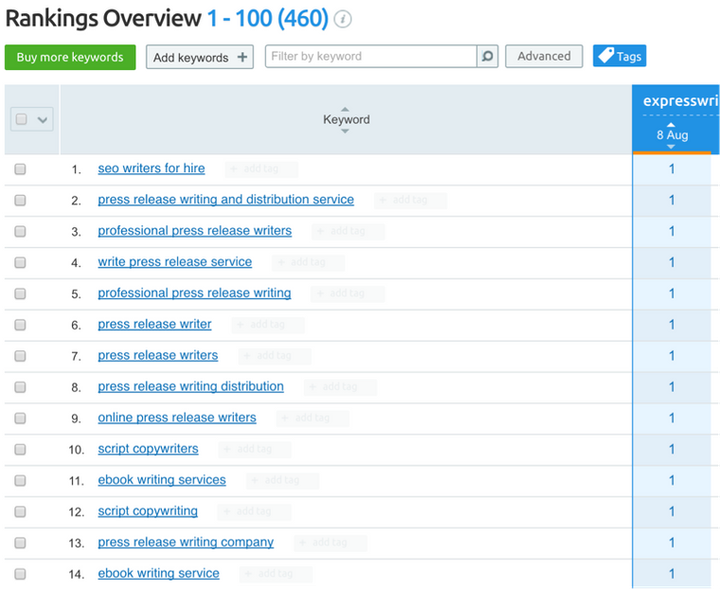
Are you a writer working with individual freelance writing clients, on a self-contracted basis?
If that’s you, good, keep reading.
Let me ask you something else.
What are your clients like?
Are they dreamboats to work with, or do you find yourself working with clients you wish you could write that I’ve-had-enough-crap email to…but of course, you can’t hit send?
I learned everything the hard way, while fast-tracking my route to success: inside a year, I taught myself how to be a freelance writer, then moved on to build a content writing agency that’s expanded to over 60 team members and hundreds of global clients in just five years.
What’s helped me succeed today is avoiding the bad clients, and organically positioning my agency to the right clients. I’m going to break that down for you now.
Know the Signs of the Good, Bad, & Ugly Freelance Writing Client
1. The Ugly: Slave Driver Mindset.
Quite literally, there are still some writing clients that treat the writer like their “slave.”
Pennies for their labor, and the labor they ask for is a long, long list of things. You’re immediately fired, or they pass on you and look for someone else if you can’t match the volume at the pay.
This is the client still stuck in old “quantity,” or volume, mindsets. There’s no value, no real client-hire relationship.
You’d be surprised (or not) how many big box brands actually try to hire in this mindset.
Look at this letter that recently came my way from a major national brand.

They were paying $4-5 per article, and keep in mind that 200 orders could be 200 x 10, 100, or 1,000 pieces of content per order.
Hundreds to thousands of articles in a single week, for one brand, written with little originality or thought.
When I started out back in 2010 as a freelance writer, I was hired by a lot of uglies. Clients were cheap-minded. Marketers thought the gold SEO standard was quantity—not quality.
When Google Panda hit hard in 2012, I saw this mindset start to die. Thrown-together, stuffed nonsense just didn’t work--or rank, and marketers had no choice but to adapt and grow.
The “10x content standard” of today demands the highest quality content—and paying less than three figures for a long-form post will not result in those standards.
Other names for the “ugly client"
Content mill. Content farm.
Action tip
If you see these emails, shudder—and run.
Let the old SEO mindset die. Stay away. Far away.
This client type needs to die out.
How to instantly know when this is coming your way:
1) High volume content requests are usually tied to content milling and farming.
2) When your price becomes an issue for their budget.
Here’s an example of a brand new contact we received where the client ended up asking for $1 per product description:

Luckily, we found out early on what their price point was going to be, and left the conversation immediately so we didn’t waste any more time.

2. The Bad: The Cheap Client
This client isn’t as bad as a slave driver, but they aren’t as golden as the “good” writing client, either.
They don’t value writing, and try to cut corners to save. In my writing agency, the most common scenario is the client who tries to invest in our general level writing instead of the expert level, because of the cost difference.
For example, a software company trying to hire a non-technical-minded writer to write an IT guide.
Sometimes, all this client needs is a solid, convincing argument on why content is high-value, and why they simply can’t cut corners. We often tell clients that with Google’s EAT and YMYL standards, expert authors (a writer who thoroughly knows the niche/topic they’re writing for) are more important than ever.
And we’ve been successful: more than 60% of our clients invest in expert-level.
But if they don’t buy the clarification on the rates you need and deserve to work at your level, stay away. They’ll be needy and cheap during the whole relationship.
Don’t be scared to push back, hard.
Here’s something to inspire you.
In mid-2015, I raised my rates by 137%, and we won after a few hard weeks. Our transparency on why we couldn’t pay or ask cheap rates was the #1 reason we came through. A few posts I wrote and emailed to our lists helped: The Dollar Days of Online Content are Gone, and another LinkedIn post detailing why we raised our rates.
Other names
Bargainer, discount fiend.
Action tip
Try convincing this client on why high-level content is needed (the skyscraper rule, 10x content, all helps to validate).
Don’t ever discount your writing. Set firm rates and keep them. Even if clients aren’t coming at the moment, they will come. Charge what you ask for, and not a penny less.
And be inspired from this Entrepreneur article where a consultant shares his leading question when people ask for half-off his speaking rates.
3. The Good: High-Value Client
This client knows that the writer “runs the show.”
They walk in, pay your rates, and defer to you for writing expertise.
They don’t get in your way. They let you work magic with your words, and thank you for your time and trouble, handing you exactly what you asked for in cash upfront, without blinking an eye.
This is the client you want to attract and work with. And if you can satisfy them, which usually isn’t too hard if you’re giving them quality, it’s an ongoing client that’s easy to keep.
Other names:
Real marketer
Two Ways to Get Your Dream Client
1. Drive leads by publishing great content, everywhere your leads are, consistently.
Your content presence is key to finding more clients who value great content.
Here’s a little secret about my content agency: we rarely pay for advertising. Instead, across the last six years I've been able to write a lot of long-form, rich content that ranks very well in Google. Our organic traffic is strong.

Here’s what our organic online presence looks like, versus major competition (some of which have millions in funding - we're 100% self-funded):

We rank #1 for a lot of super high-targeted keywords.

Two ways I focus on creating content that has high ROI:
1) Writing long-form content on my site, a big core to my site rankings
Every subject I write on, I make sure I write a guide that goes 100% in-depth on the topic (often resulting in 2,000-5,000 words). Our team members guest blog on our site sometimes, too. We audit frequently, write fresh content, and update old posts.
Since 2011, we’ve accumulated over 850 blog posts. I also run a Twitter chat, #ContentWritingChat, and podcast that adds even more weekly content in the form of show notes and recaps to our site. Some of our posts include infographics, gifographics, and videos.
In short: we invest in consistently putting a ton of quality content on our real estate (our own site).
2) I guest blog on platforms where my leads exist
It’s taken me years to get on some of the channels I’m on, which include Search Engine Journal, Content Marketing Institute, Huffington Post, and SiteProNews, to name a few of the top ones. I’ve seen a lead walk in from just one SiteProNews guest post and convert at $5,000.
I have ongoing columns at all the guest blog channels I'm on, so I'm not just a fly-by-night name that's forgotten. That helps me stay positioned as an expert, put my bio in front of traffic over and over, and eventually be at the forefront when people consider where to look when they look for a content creation agency.
2. Weed out the sketchy leads before they become clients
Do your research on the leads who approach you. Since you might not be shaking their hand most of the time in person, look at their online business reputation. “Vet” them: Google their name, do a Glassdoor search. Ask for a Skype live video call if you feel they’re questionable.
If you find anything that points to a bad, low-quality, ill repute client, stay far away. Another one to avoid is the “good” client who could be 100% affable but has no clue what they’re doing online. That client will become a baby that you’ll end up “sitting.”
The exception here is a solid company with a great presence that shows you right away you won’t need to convince them on budget, price point, or accommodating your needs. You won’t need to interview them at all—they’re too busy to waste too much of your time, and you won’t need to waste theirs.
We see clients come our way that are completely willing to invest in content creation at our price points, and will put down $5,000 within a week after getting approval from their CEO/COO for the funding.
It will happen, when you hit on the right lead quality.
When serious clients come your way, they know what they want, and you can tell.
Go with your gut.
Conclusion
A question I’ve asked myself often: why does the ugly client mindset even exist?
Simply put, because writers are still settling.
Let's all agree to never, ever lower our rates, even if you feel you need the gig to pay tomorrow's bill. Don't settle. Change the way marketers look at content creators.
And across the board, we’ve noticed a trend among the clients that we prize.
They stay if the quality and efficiency is there: if we meet reasonable deadlines, and present high quality.
If we drop any aspect, from deadlines to spelling issues, they start getting scared—and think about getting backup.
So, if you find a good client, make it your priority to serve them well. They’ll appreciate you for it.
A reliable, awesome, dedicated writer isn’t something that’s easy to find.
This post originally appeared on Inbound.org. Visit Julia’s site, or follow her on Twitter.
